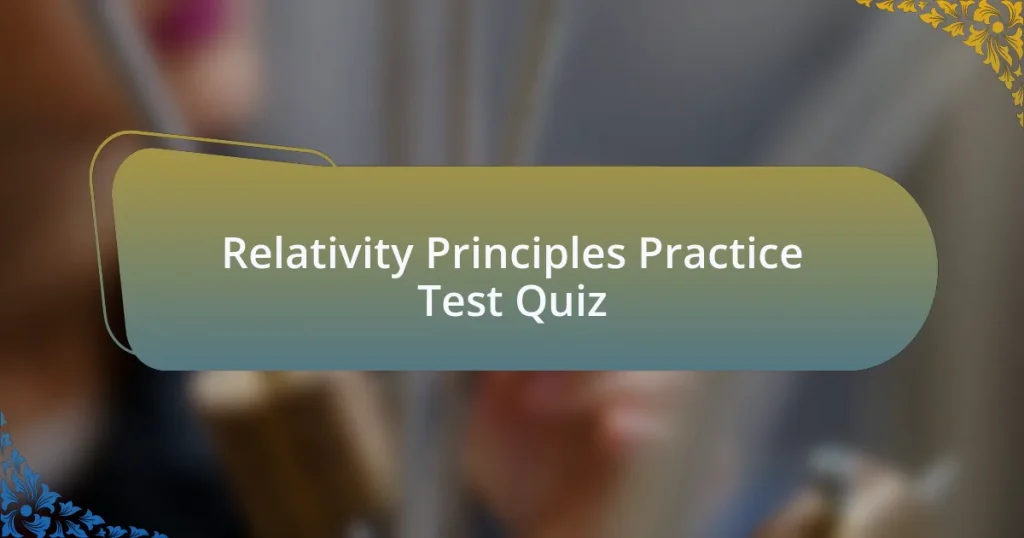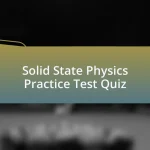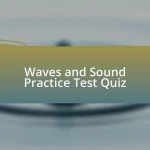Start of Relativity Principles Practice Test Quiz
1. Which theorem defines the structure of space-time?
- Special relativity theory
- Newton`s law of motion
- Law of thermodynamics
- Quantum mechanics principle
2. State true or false: Light rays will bend in the gravitational field.
- MAYBE
- NOT SURE
- TRUE
- FALSE
3. Name the fundamental forces in the universe.
- Sound, heat, light, and magnetic forces.
- Gravity, electromagnetism, the weak force, and the strong force.
- Magnetism, inertia, radiation, and centrifugal force.
- Friction, tension, buoyancy, and drag force.
4. What is the speed of light in miles?
- 186,000 miles/sec
- 175,000 miles/sec
- 150,000 miles/sec
- 200,000 miles/sec
5. Which theory gives the relationship between space and time?
- Newtonian physics theory
- Classical mechanics theory
- Quantum mechanics theory
- Special relativity theory
6. Theory of Relativity features which theories?
- Thermodynamics and fluid dynamics
- Quantum mechanics and wave theory
- Newtonian mechanics and classical physics
- Special relativity theory and general relativity theory
7. Who developed the special theory of relativity?
- James Clerk Maxwell
- Isaac Newton
- Niels Bohr
- Albert Einstein
8. State true or false: The speed of light varies with respect to the person who measures and how fast the person measures it.
- TRUE
- FALSE
- DEPENDS
- MAYBE
9. Which law is put forth by Albert Einstein?
- Law of relativity
- Law of thermodynamics
- Law of inertia
- Law of gravity
10. Mass–energy equivalence is given by the formula _____.
- E=mc^2
- F=ma
- a=Δv/Δt
- p=mv
11. Explain the relativity theorem.
- The relativity theorem states that space and time are absolute and do not change with the observer.
- The relativity theorem states that gravity is an illusion and does not affect motion.
- The relativity theorem states that space and time are relative, and all motion must be relative to a frame of reference.
- The relativity theorem states that time flows at a constant rate for everyone, regardless of speed.
12. State the special theory of relativity.
- The special theory of relativity explains the relationship between space and time, and it states that the speed of light is constant for all observers.
- The special theory of relativity claims that mass increases with speed, making it impossible to accelerate to light speed.
- The special theory of relativity suggests that time travels faster than light for all observers.
- The special theory of relativity states that space and time are fixed and unchanging for all observers.
13. State the general theory of relativity.
- The general theory of relativity explains how gravity affects space and time, and it states that mass warps space-time.
- The general theory of relativity claims that gravity is a force that acts at a distance without affecting space-time.
- The general theory of relativity describes gravity as a repulsive force between two masses.
- The general theory of relativity states that time is absolute and does not change.
14. Explain the concept of length shrinking.
- Length shrinking occurs when an object is at rest compared to an observer.
- Length shrinking occurs when an object is moving at relativistic speeds; its length appears shorter to an observer at rest.
- Length shrinking is the phenomenon where the speed of light increases with speed.
- Length shrinking refers to the process of an object expanding when it moves.
15. What is mass-energy equivalence?
- Mass-energy equivalence is the concept that mass cannot be converted into energy.
- Mass-energy equivalence states that mass and energy are completely unrelated.
- Mass-energy equivalence means that energy exists independently of mass.
- Mass-energy equivalence is the principle that mass and energy are interchangeable, as expressed by E=mc^2.
16. A spaceship is 145 meters long and passes through a timing station at 0.675 c. What will the timing station measure for the time of the spaceship from its front to end?
- 0.108 seconds
- 0.215 seconds
- 0.910 seconds
- 0.578 seconds
17. Person A moves towards Person B at 0.5c. Person B shines a line at Person A. Assuming the inertia frame of reference, what value of A will measure for the speed of light of the beam?
- 1.5c
- 0.75c
- c
- 0.25c
18. At noon, ship A is 80 km west of ship B. Ship A is sailing south at 10 km/h and ship B is sailing north at 5 km/h. How fast is the distance between the ships changing at 4:00 PM?
- The distance between the ships is increasing at a rate of approximately 15 km/h.
- The distance between the ships is decreasing at a rate of 5 km/h.
- The distance between the ships is constant at 80 km.
- The distance between the ships is increasing at a rate of 10 km/h.
19. A car travels due east with a speed of 38.0 km/h. Raindrops are falling at a constant speed vertically with respect to the Earth. The traces of the rain on the side windows of the car make an angle. What is the angle?
- 30 degrees
- 90 degrees
- 60 degrees
- 45 degrees
20. In deriving the relativistic mass using the example of two balls colliding, which law of physics is violated if we assume that mass is constant?
- The law of conservation of momentum is violated if we assume that mass is constant.
- The law of universal gravitation is violated if we assume that mass is constant.
- The law of thermodynamics is violated if we assume that mass is constant.
- The law of conservation of energy is violated if we assume that mass is constant.
21. Using the Lorentz transformations, calculate the length that a 1-meter rod would appear to you if it were moving at a speed of 0.8c relative to you.
- 1 meter
- Approximately 0.6 meters
- 0.8 meters
- 0.4 meters
22. Using a suitable example, explain what is meant by the term Galilean Relativity.
- Galilean Relativity suggests that time is constant regardless of speed, as shown by ships moving in water where time flows the same for all.
- Galilean Relativity states that the laws of physics apply equally across all inertial frames of reference, illustrated by a train moving uniformly; inside, a ball thrown vertically returns to the thrower`s hand, demonstrating that motion is relative.
- Galilean Relativity states that objects cannot exceed the speed of light, evidenced by a car accelerating on a straight highway with constant time for all observers.
- Galilean Relativity indicates that speed is only relative to nearby observers, shown by two cars racing side by side with no relative acceleration observed.
23. The great astronomer Edwin Hubble discovered that all distant galaxies are receding from our Milky Way Galaxy with velocities proportional to their distances. What does this observation imply about the expansion of the universe?
- The universe is collapsing into a black hole.
- The universe is static.
- The universe is expanding.
- The universe is contracting.
24. In the theory of relativity, the mass of a particle with velocity v is m = (m0)/(sqrt(1 – v^2/c^2)). What happens as v approaches c?
- The mass of the particle decreases towards zero as v approaches c.
- The mass of the particle remains constant as v approaches c.
- The mass of the particle oscillates as v approaches c.
- The mass of the particle approaches infinity as v approaches c.
25. A proton moves with a speed of 0.920c. Calculate its rest energy.
- approximately 938 MeV
- approximately 186,000 MeV
- approximately 0.12 GeV
- approximately 1.04 GeV
26. At what speed will an object`s kinetic energy be 19% of its rest energy?
- The speed is approximately 0.80c.
- The speed is approximately 0.60c.
- The speed is approximately 0.95c.
- The speed is approximately 0.70c.
27. Does gravity affect light?
- No, gravity has no effect on light.
- Yes, gravity strengthens light`s speed dramatically.
- No, light travels faster in a gravitational field.
- Yes, gravity affects light, causing it to bend according to general relativity.
28. According to relativity, describe how a falling object looks to an observer in a windowless bus.
- The falling object looks stationary to the observer in the windowless bus.
- The falling object appears to float in mid-air for the observer in the windowless bus.
- The falling object appears to be moving in a straight line to the observer in the windowless bus.
- The falling object appears to move in a circular path to the observer in the windowless bus.
29. Describe the space-time interaction with mass.
- Mass has no effect on the structure of space-time or gravitation.
- Mass creates a vacuum in space-time, leading to a flat dimension.
- Mass warps space-time, causing it to curve and bend according to general relativity.
- Mass speeds up the rate of time passage in all areas of space-time.
30. The special theory of relativity deals with space and time under what `special` condition?
- Variable acceleration
- Absolute speed
- Stationary observers
- Constant relative motion
Congratulations on Completing the Relativity Principles Practice Test!
Well done on finishing the quiz focused on the principles of relativity! This assessment offers a valuable opportunity to deepen your understanding of key concepts in physics. By engaging with the questions, you likely refined your knowledge of essential ideas like time dilation, the theory of relativity, and the relationship between space and time. These principles form the backbone of modern physics and are vital for anyone preparing for advanced studies in this field.
Completing this quiz not only tests your knowledge but also helps reinforce what you’ve learned. Each question provides insight into the complexities of relativity and its practical implications in our universe. Whether or not you achieved a perfect score, every attempt contributes to your overall grasp of the subject. This process encourages critical thinking and analytical skills vital for success in physics.
We invite you to explore the next section on this page dedicated to ‘Relativity Principles Practice Test.’ Here, you will find additional resources and explanations that will further clarify these concepts. Expanding your knowledge in this area can significantly enhance your test preparation efforts. Dive deeper into the fascinating world of relativity and continue building your physics expertise!
Relativity Principles Practice Test
Understanding Relativity Principles
Relativity principles refer to the foundational concepts introduced by Albert Einstein in the early 20th century. These principles include the Special Theory of Relativity and the General Theory of Relativity. Special Relativity focuses on the physics of objects moving at constant speeds, particularly at velocities approaching the speed of light. It radically changed our understanding of time and space. General Relativity expands on this by describing gravity as the curvature of spacetime caused by mass. Understanding these principles is crucial for solving problems in physics related to high-speed motion and gravitational phenomena.
Types of Questions in Relativity Principles Practice Tests
Practice tests on relativity principles generally include multiple-choice questions, conceptual questions, and problem-solving exercises. Multiple-choice questions often assess definitions and key concepts. Conceptual questions challenge students to explain principles in their own words, while problem-solving exercises require application of equations, such as time dilation and length contraction. Each type of question reinforces different skills crucial for mastery in physics. Effective practice tests cover a range of difficulties to cater to varying levels of student understanding.
Key Equations in Relativity Principles
The key equations in relativity include Einstein’s mass-energy equivalence formula, E=mc², and the Lorentz transformation equations. E=mc² illustrates the relationship between mass (m) and energy (E), indicating that they are interchangeable. Lorentz transformations describe how measurements of time and space change for an observer in relative motion. These equations are essential for solving problems in relativity, as they allow students to calculate effects such as time dilation and relativistic mass. Mastering these equations is vital for success in any relativity practice test.
Common Misconceptions in Relativity Principles
Students often hold misconceptions about relativity, such as confusing relative motion with absolute motion. There is also a misunderstanding that time can be “slowed down” or “speeded up” in a simple, linear manner. Additionally, students may struggle with the concept that mass increases with velocity. These misconceptions can hinder problem-solving abilities in practice tests. Addressing these common errors through targeted learning can greatly improve comprehension and test performance in relativity principles.
Strategies for Preparing for Relativity Principles Practice Tests
Effective preparation for practice tests in relativity principles involves several strategies. First, students should study key concepts thoroughly, using textbooks and online resources. Second, solving a wide range of practice problems helps reinforce understanding and enables familiarity with various question types. Third, group study sessions can stimulate discussion and clarification of difficult topics. Finally, reviewing incorrect answers from past tests can identify weak areas, allowing focused improvement. These strategies enhance readiness for tackling relativity principles effectively.
What is a Relativity Principles Practice Test?
A Relativity Principles Practice Test is a set of assessment questions designed to evaluate a student’s understanding of the principles of relativity, primarily focused on Einstein’s theories of special and general relativity. These tests include problems related to time dilation, length contraction, and the equivalence of mass and energy, testing the application of the formula E=mc². They are essential for students preparing for physics exams, offering a structured way to reinforce theoretical knowledge through practical problem-solving.
How do you prepare for a Relativity Principles Practice Test?
To prepare for a Relativity Principles Practice Test, a student should first review the key concepts of relativity, including spacetime, the speed of light invariant, and gravitational effects on time and space. Practicing problems from textbooks or online resources is crucial. Additionally, utilizing previous exams or practice tests specifically focused on relativity principles can help. Understanding commonly tested problems, such as those involving relativistic speeds, is vital for effective preparation.
Where can you find Relativity Principles Practice Tests?
Relativity Principles Practice Tests can be found in several places, including online educational platforms, university course websites, and physics study websites. Resources like Khan Academy, Physics Classroom, and Study.com offer practice questions and tests. Academic publishers also provide workbooks and study guides that include sections dedicated to test preparation for relativity principles.
When should you take a Relativity Principles Practice Test?
A Relativity Principles Practice Test should be taken after reviewing relevant theoretical material and completing practice problems. Ideally, students should take the test a few weeks before a scheduled exam to identify areas needing improvement. Timing is crucial; taking the practice test under exam conditions can enhance readiness and confidence in mastering relativity concepts.
Who can benefit from a Relativity Principles Practice Test?
High school and college students studying physics can benefit from a Relativity Principles Practice Test. Those preparing for AP Physics exams or introductory college courses will find these tests particularly useful. Furthermore, individuals pursuing advanced studies in physics or anyone interested in understanding relativity at a deeper level can gain insights through practice tests. These assessments serve as valuable tools for reinforcing knowledge and boosting confidence.















